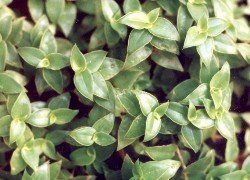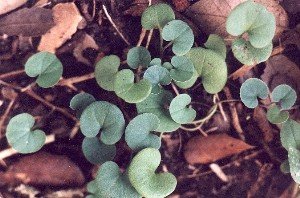Favorite Groundcovers
by Valerie (November 9, 2002)
Most of our plants manage to cover the ground. In fact, they do it very efficiently so that there is little bare dirt to be found once I've added plants, spread seed, and allowed the various weeds to grow. However, a few species really are considered to be ground covers, mostly because of their low manner and creeping habit.

Common English ivy (Hedera helix) has many cultivars, only a few of which are suited to our climate. We are able to grow the solid green kind on the north side of the house, where the soil remains relatively wet and the sun does not beat down on it. In spite of some success with the ivy, at various times entire sections will die, most often during very hot weather. Because the little pots of ivy are sold cheaply at most nurseries and plant departments, I like to experiment with whatever happens to be available. Most end up dying either from freezes or from heat. However, one ivy plant, pictured at right, really did well. One of the variegated types, it was planted next to the pile of rocks that serves as a waterfall for our smaller, older pond. For about 10 years, it grew bigger and bigger, covering the rock pile in an aesthetically pleasing way, and thriving in the shade. Unfortunately, this past summer it simply died. The entire plant had never rooted anywhere else, all the stems, some several feet in length, still emerged from the original root. It could have been that the long period of flooding did it in, or it could have had some sort of pest attack. I will look for a replacement soon.
Another of my favorites is a new addition. Received from a friend, two clumps of little jewel (Callisia repens) have been spreading admirably all summer. This relation of wandering Jew and spiderwort seems to have a lot of common names, such as creeping inchplant, Bolivian Jew, turtle vine, basket plant, itsy bitsy inch plant, tiny buttons, and jellybean plant. Most books list it as being suited to a zone 10 garden, but, from the look of the overgrown areas in my friend's garden, it certainly does well here in 8b. It will freeze back, but then sprout again in the spring. Considering that even the houseplant wandering Jew manages to survive our winters, there is a lot to be said for a little mulch and plenty of leaf litter when it comes to weathering the freezes. The microclimes within our yard are still not fully comprehensible so I just take a guess as to where something might survive. The little jewel is spreading rapidly and has beautiful leaves. It is now flowering but the flowers are of little interest to anyone but the insects, being small, white, and almost hidden on the stems. Although the plant will probably survive the winter, I'm not taking any chances and have added a couple of sprouts to some potted plants so they will be protected during the freezes this year.
The final ground cover presented here is a weed in our lawns, gardens, and even between the bricks of walkways. Kidney grass (Dichondra repens or D. carolinensis) is an Australian native that seems to have naturalized all over the world. It is also called kidney weed and ponyfoot. Although it prefers moist habitats, it manages to survive in our lawn, but does best when watered. When searching for more information about this plant, I discovered that some nurseries sell it as an excellent ground cover for rock gardens, and it really does look lovely, forming thick, green mats of solid round little leaves. Other sites have pages devoted to methods of removing it from lawns. What is one person's prized plant is another's weed. Although we don't have much of the plant, wherever it grows, I try to encourage it. The leaves range up to about an inch in diameter and the plant creeps along at ground level, never getting more than about two inches tall. It seems to harmlessly fill in the gaps in the grass, while remaining below the level of the lawnmower, so it adds some much appreciated green to the lawn. The flowers it produces are absolutely tiny and can only be seen if the leaves are lifted up. There is also a species of kidney grass that is silver in color and quite stunning in its effect as a rock plant, but it needs too much water and seems to prefer a cooler climate. |

